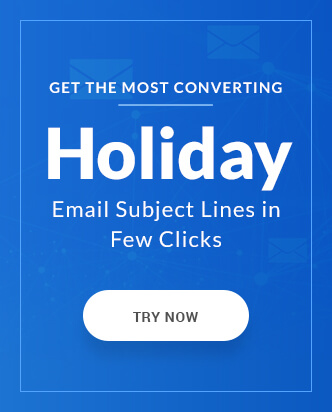An email marketing campaign can be an excellent investment for your company if done properly. Whether you’re sending a promotional email to recommend products and boost sales, a welcome email to make the customers feel a part of your family, or a thank you email to express your gratitude, it contributes to the profit of your company. Hence, you need to be cautious throughout the email marketing process to deliver quality.
We all are humans and the occurrence of a mistake is a probability. The same happens with email marketing. Whether you are a professional or a newbie, you might commit any of the common email marketing mistakes while sending the email campaign. Hence, to avoid it in your campaign and reap the full potential of email marketing, we have listed some of the most common mistakes that commonly happen to the marketer.
10 Most Common Email Marketing Mistakes
-
Do Not Test & Improve their Emails
Merely drafting and pushing the email in the subscriber’s inbox does not make your email marketing campaigns successful. You need to test its performance frequently to achieve this. Testing gives you an idea about loopholes responsible for the failure of your email marketing campaign, based on which you can make improvements in your email and upgrade performance.
Before sending your emails to the subscribers you can perform A/B testing to check its performance. With A/B testing, you can not only improve your email marketing campaign performance but also learn the nitty-gritty of the performing and nonperforming elements and practices which you can use to prevent mistakes in your campaign. -
Choosing the Wrong Type of Email
Email marketing proves to be extremely effective in nurturing the customer throughout its life cycle with your brand. But even the rich set of colors cannot decide the fate of your painting; it’s the way you use it. The same set of colors can create a masterpiece as well as a disaster based on the choice of colors and the process of usage. The same holds for email marketing which if used appropriately can work wonders for your brand however in other ways it might lead to big losses.
You should not send the emails to the subscribers just for the sake of sending; it should conform to the customer’s life cycle stage. For example, you cannot send a welcome email to existing customers or vice-a-versa. Choosing the wrong email might annoy the customer preventing him from opening your email in the future. -
Using Non-personalised Email Templates
Imagine you go to a clothing store, where they address you with your name and offer you personalized offers based on your past shopping preferences. Won’t you feel special and happy with their services? The same happens with your personalized emails.
Personalization makes the email more attractive to the subscriber encouraging him to interact with the email content. Personalized emails are more likely to get opened and drive more revenue up to 18 times as compared to the non-personalized ones. The non-personalized email appears more like a general bulk email which the subscriber avoids opening.
Email personalization can be done in various ways like including the name of the subscriber, giving customized offers, image location product recommendation, and so on. Here is a great example of email personalization used by ING Australia which not only personalizes the subject line using the name of the recipient but also so designs the email content based on the customer’s interest. -
Not Using Call-To-Action
You have crafted a wonderful email with meaningful and creative content reading which the subscriber is extremely delighted and desires to take the relationship further through an action. But what if he does not find the click to action button to take the journey ahead.
The subscriber need not bother to go to a browser, open your website, and find out what’s going on. He quickly closes the email and starts going through the other emails in his inbox. Did you notice missing a single element that is the call to action button can make you lose a good opportunity?
The best approach is that before you start drafting your email, settle down on a clear goal that you want to achieve. This helps you in creating a compelling CTA for your email that guides your subscriber for the further process. Here are some useful tips, you should consider while creating your CTA-- Easily locatable
- Comprehensible
- Frequency of using CTA in the email
- Color of the CTA button
- Visibility of the CTA
-
Sending Incorrect Information
Your email copy contributes to your brand image requiring you to be careful about the details like email design as well as the information in it. An inappropriate email design or misleading information within the email can leave a very bad impact on the subscribers. The most common mistakes that occur in the aspect of information are-
- Sending an email to the wrong subscribers
- Broken Links
- Wrong Links
- Including incorrect details like dates, product price, events, etc.
- Fake discount coupons
- Offensive content
Such mistakes occurring frequently, raises questions on the credibility of the brand, gradually pushing you towards their spam list. So try to avoid this kind of mistake within your email copy however if in case it occurs make a quick apology to your subscribers. If a mistake occurs one time in forever the customer does understand and forgive your mistake. However, if it happens frequently or you do not address it with an apology or make-up for it, it might lead to the customers losing confidence and interest in your brand.
So, for longer customer retention, make sure to apologize for your mistake and make up for it just like in the following example. This shows your responsible behavior to the customer thereby gaining their confidence.Source: Really Good Emails
-
Plan to Handle Mistakes
Business is a long term journey, in which you cannot assure a flawless process throughout. Mistakes do occur which cannot be undone but can be improved. Though you should try to avoid any kind of mistake, preparing for unexpected mistakes is equally important. This will help you to handle the situation smoothly.
To start with, jot down all the possible issues that might occur in the email marketing journey. Classify the issues based on the urgency of response. Not all the issues need your response, some issues like a casual spelling mistake can be left unattended without drawing light on it. However, in the other case, you have to be prepared.
Decide how a particular issue needs to be addressed. Whether you should send an apology email or print an apology letter, address on social media, or something else. Also, you can outline the apology email and create an effective email template to save your time. -
Not Using Segmentation
Email segmentation plays a very important role in email relevancy. A business caters to a wealth of audiences dwelling in different stages of the customer lifecycle. Based on the stage they are in, they require a different kind of information/content. If you serve them irrelevant content continuously, there are chances that your subscriber might unsubscribe from your newsletter, or spam you. Segmentation helps you serve your subscribers with relevant content, hence considered as one of the most effective personalization tactics by 51% of marketers.
Subscribers don’t like to indulge in irrelevant content. The more relevant and personalized is the content of the email, the higher is its opening rate. You can segment your email based on numerous factors like-- Location
- Age criteria
- Gender-based
- Language
- Customer’s Interests
- Shopping Behaviours
- Regional Beliefs
-
Not optimizing the Emails for Mobile
As technology is advancing, moving away from desktops to mobile devices, mobile email marketing is becoming extremely critical for companies. 50% of emails are opened on mobile devices. Hence, if you are not optimizing your emails for the mobile devices and designing it responsively, there are chances that your emails might be closed within 3 seconds. If a user is not able to access your email properly, the probability of the success of the email marketing campaign diminishes.
Source: Juvlon -
Sending Filler Emails
Consistency is important to build a strong relationship with the customer. However, sending filler emails to remain consistent merely to fulfill the schedule, is a bad idea. You should always deliver value to your customer to sustain them longer. So before you start drafting your email, set up a goal for your campaign. Determine what you want to convey to your customers. Once decided, draft your email accordingly and then send it. Missing a schedule won’t damage your image that much as an irrelevant email might do.
-
Not Choosing the Right Email Marketing Tools
The initial step to surpassing your business objectives is picking the correct email marketing tool. The right tool can bring a huge difference to your email marketing campaign. However, if you are using a tool that does not comply with your campaign goal, you might be keeping your business away from some great opportunities. To avoid this, you should check out its features to ensure you pick the tool that turns out best for you and your organization.
Wrap-up
Preparation not only prevents you from big damages but also helps you handle the situations smoothly. And now that you are acquainted with some of the most common mistakes that happen during the email marketing process, you can prepare for the mistakes and plan out your campaign to mitigate such mistakes easily. For more information or further guidance on Email Marketing campaigns, Reach out to our Marketing Experts, and add value to your campaign.



